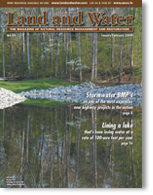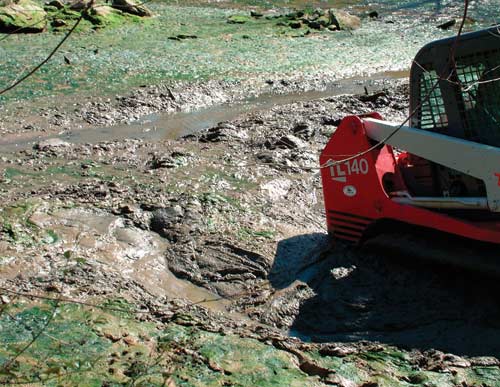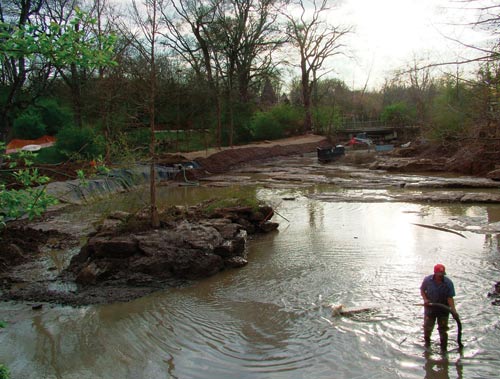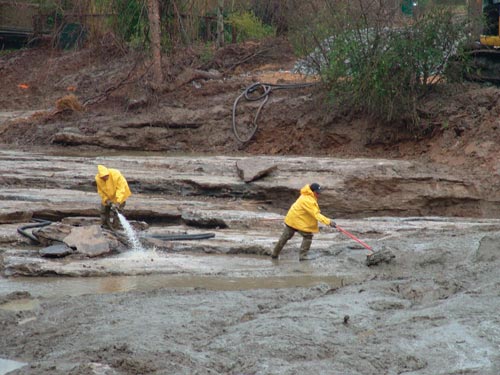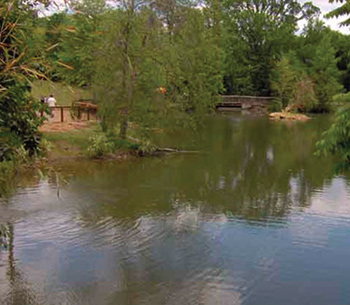Innovation in Erosion Control:
|
||
Nashville Zoo offers many animal species found around the world. These beautiful creatures can be found in equally beautiful habitats. One of the first habitats you see upon entering the zoo is Croft Pond. This habitat has been home to various species of waterfowl, from Saddle-billed Storks to Black Neck Swans, and is mainly a large pond measuring roughly 90’ x 260’ with 23,400 ft2 surface area. The pond has deep caverns measuring one to two feet deep. The bottom was made of natural limestone and the sides are stratified with weathered limestone, sandstone, and clay. Historically the Croft Pond has water quality problems due to low flow in the summer, leaks, a contaminated spring, and stormwater run-off from an industrial park. In 2004 Rick Schwartz, the President of Nashville Zoo, had contacted Jen-Hill to make repairs twice to seal the dam but both efforts were unsuccessful. The dam had begun pulling away from the bank, forming huge crevasses around the edges and cracks in the dam surface. The cracks were patched and earth packed into the fissures, however water continued flowing through the area allowing further erosion to occur. Baldcypress roots, Rivercane roots, and Muskrats had allowed avenues to develop outside the concrete boundaries, causing additional problems.
In March of 2005, Gary Moody, a Stormwater and Water Quality Consultant from Jen-Hill, was called to the site because the lake had completely drained after a mild storm event. Due to the location of Croft Pond in the central area of the zoo, large equipment, like backhoes and large dump trucks, could not be brought in. But before repairs could be made, the sediment accumulated needed to be removed. The sediment had naturally occurred, deposited in the pond from the stream and stormwater ditch that emptied into the pond. However, the soupy mess that was left at the bottom of the pond after the water drained off would be extremely difficult to remove with conventional methods. Since it is difficult to get full bucket loads of the soupy mud, larger buckets are normally used to move the most material possible. The limitation on the size of the equipment able to access the pond would greatly prolong the project.
It was estimated that there was 7000 tons of sediment to be removed, covered by 3 feet of water. The water had slowly accumulated from subsequent storm events and runoff as well as the natural feed for the pond. Kevin Surprise, of 5K Construction, found that large excavating equipment could not be used, as there was limited access to the pond due to the zoo’s surrounding walkways. Even the small trackhoe that was brought in and placed on the bank had trouble. Between the muskrat activity along the banks, and the large crevices in the concrete bottom of the pond, it was too unstable to operate safely. Because of these limitations, Gary Moody decided to use Applied Polymer System’s products. Floc Logs were used for controlling turbidity in the water pumped off the pond site, to prevent sediment problems from developing further down the system. They were also used to stabilize the spring-fed stream pouring the organic materials into the Croft Pond, as well as the stormwater ditch flowing into the site. Silt Stop was used here to thicken the sediment in the pond, as well as stabilizing the banks from erosion while the equipment was brought in. He had worked with these products before, and was familiar with their superior performance. Since APS’s polymer products are matched to the specific lithology of each site they are used at, Gary sent soil and water samples to the their testing lab to match the PAM blend to the site. The project was expected to cost over $130,000 and take 28 days to complete. This proved to be the most economical solution, as there was realistically no other way to do the project between the constraints of the limited access to the site, and keeping the rest of the zoo fully operational.
To start, the dam was closed to contain the sediment. Incoming flow was intercepted and pumped to a dry detention wetland, effectively creating a zero-flow environment at the pond site. During storms, the excess water was handled by continually returning the Stormwater back to the Detention pond. The remaining water downstream was pumped into a detention area that was created onsite to handle the additional runoff from the Elephant exhibit. The water was directed under the path through a culvert, treated with Floc Logs, and the clean water was returned to the stream. This treatment caused the silt to drop out in less than 60’ onto a geotextile fabric, which was then dried out and rolled up for disposal at a debris site on the back of the Zoo.
Each day the pumps were started early and the clean water discharged over the Floc Logs to remove the suspended solids before diversion into a stormwater detention area that had been constructed previously as part of the requirements for the Elephant exhibit. The two acre detention area was a mitigation for the Elephant exhibit, which is within the same watershed. After 2 hours of dewatering each morning, sediment removal would begin on the areas isolated and stabilized using Silt Stop powder the afternoon before. Occasionally the powder was added directly to the water surface and then mixed into the water and underlying soils by submerging a pump nozzle into the water and soils beneath thus solidifying the soils for removal. Once the muck had solidified, it could be easily scooped up and transferred into a single-axle dump truck and hauled away. After the sediment was removed, an island was constructed for the birds. Tensar BX Geogrid was used to stabilize the local rocks and soils that the island was built from. Repairs to the dam were made with GSE Polylock, a mechanical anchor system, and a geomembrane. The geogrid was used as a reinforced earth structural material, laid horizontally, spanning from outside rock to outside rock in 1’ lifts. Rocks were placed on the outside perimeter of the island and then the interior was filled in lifts with stone to within 2’ of the surface. Hydric soil was added to reach to the top of the water, and then topsoil was added to a height of 3’ above the water.
The anchor system was attached to the dam and extended from the face of the dam into the slope. It was fastened to the dam using Hilti bolts and vibrated into place. This material was used to prevent further damage from the muskrats, as they are unable to chew on the HDPE. This barrier prevents the pond from accidentally draining again, and protects the water from further off-site contaminates. Re-vegetation of the exhibit, overseen by Kelly Flora and Ben Moody, used native Riparian plants, special grasses, and wetland sod grown by Jen-Hill. Once complete, the pond was reopened, and is the new home to the Black Neck Swan exhibit. For more information, contact Lissa Snowdon, Environmental Scientist, Applied Polymer Systems, info@siltstop.com. |
©2006 - 1998 Land and Water, Inc.

